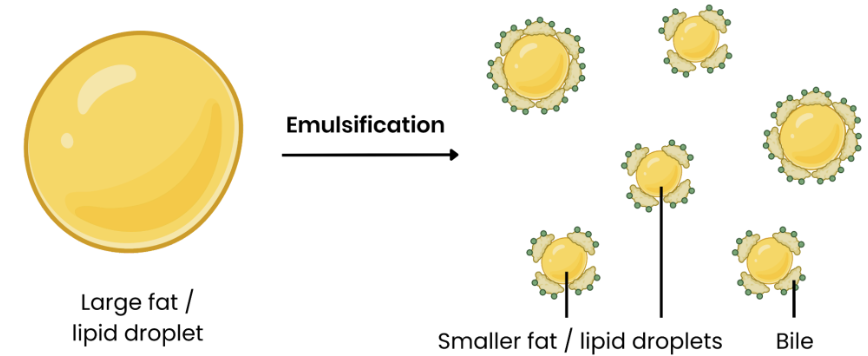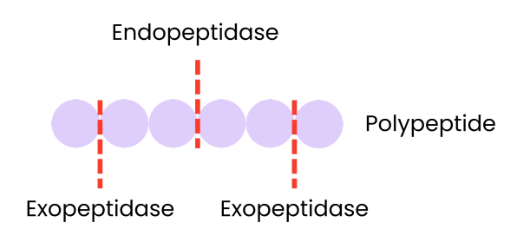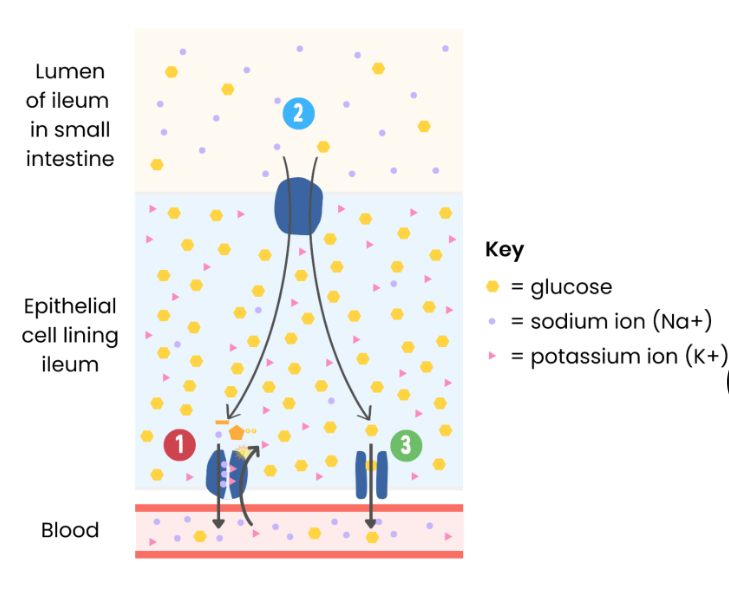3.3 Digestion and absorption
1/8
There's no tags or description
Looks like no tags are added yet.
Name | Mastery | Learn | Test | Matching | Spaced |
|---|
No study sessions yet.
9 Terms
Explain what happens in digestion.
Large (insoluble) biological molecules hydrolysed to smaller (soluble) molecules, that are small enough to be absorbed across cell membranes into blood.
Describe the digestion of starch in mammals.
Amylase (produced by salivary glands/ pancreas) hydrolyses starch to maltose.
Membrane-bound maltase (attached to cells lining ileum) hydrolyses maltose to glucose.
Hydrolysis of glycosidic bond.

Describe the digestion of disaccharides in mammals
Membrane-bound disaccharidases hydrolyse disaccharides to 2 monosaccharides.
Maltase hydrolyses maltose → glucose + glucose.
Sucrase hydrolyses sucrose → fructose + glucose.
Lactase hydrolyses lactose → galactose + glucose.
Hydrolysis of glycosidic bond.
Describe the digestion of lipids in mammals, including action of bile salts.
Bile salts (produced by liver) emulsify lipids, causing them to form smaller lipid droplets.
This increases surface area of lipids for increased/ faster lipase activity.
Lipase (made in pancreas) hydrolyses lipids (e.g. triglycerides) → monoglycerides + fatty acids.
Hydrolysis of ester bond.

Describe the digestion of proteins by a mammal
Endopeptidases - hydrolyse internal (peptide) bonds within a polypeptide → producing smaller peptides.
so more ends/ surface area for exopeptidases.
Exopeptidases - hydrolyse terminal (peptide) bonds at ends of polypeptide → producing single amino acids.
Membrane-bound dipeptidases hydrolyse (peptide) bond between a dipeptide → producing 2 amino acids.

Suggest why membrane-bound enzymes are important in digestion.
Membrane-bound enzymes are located on cell membranes of epithelial cells lining ileum. → by hydrolysing molecules at the site of absorption they maintain the concentration gradients for absorption.
Describe the pathway for absorption of products of digestion in mammals.
Lumen (inside) of ileum → cells lining ileum (part of small intestine) → blood
Describe the absorption of amino acids and monosaccharides in mammals.
Co-transport:
Na+ actively transported from epithelial cells lining ileum to blood (by sodium/ potassium pump)
establishing a concentration gradient of Na+ (higher in lumen than epithelial cell).
Na+ enters epithelial cell down its concentration gradient with monosaccharide or amino acid against its concentration gradient - via a co-transporter protein (carrier protein).
Monosaccharide or amino acid moves down a concentration gradient into blood via facilitated diffusion.

Describe the absorption of lipids by a mammal, including the role of micelles.
Bile salts combine with monoglycerides and fatty acids to form micelles.
Micelles make monoglycerides and fatty acids (more) soluble in water.
Micelles carry fatty acids and monoglycerides to cells lining the ileum, where they break down to release them.
This maintains a high concentration of fatty acids and monoglycerides near cells lining the ileum.
Monoglycerides/ fatty acids are absorbed (into epithelial cells) by diffusion (as they’re lipid soluble).
Triglycerides formed in (epithelial) cells and aggregate into globules.
Globules coated with proteins forming chylomicrons which are then packaged into vesicles.
Vesicles move to cell membrane and fuse with it, releasing chylomicrons via exocytosis.
Chylomicrons enter lymphatic vessels and eventually return to blood circulation.